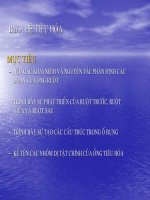BAI GIANG HE TIEU HOA
Bạn đang xem bản rút gọn của tài liệu. Xem và tải ngay bản đầy đủ của tài liệu tại đây (1.02 MB, 41 trang )
Gastrointestinal/digestive system
Objectives:
- Functions of the digestive system
-Basics of food digestion process: hydrolysis reactions of food
molecules
-Structures and components of digestive system
-General structure of the wall of gastrointestinal tract
-Digestion in the mouth
-Digestion and absorption in the stomach
-Digestion and absorption in the small intestine
- Secretion and motility of the GI tracts
Why we need a digestive system ?
Biosynthesis
Digestion
•
Cells need nutrients for its structure and energy for it activities
•
Foods are macromolecules which can not be directly absorbed by
cells
Digestion is a process containing
hydrolysis reactions of food molecules
enzyme
• Polysaccharide +H2O --> monosaccharides
enzyme
• Protein + H2O -–> amino acids
enzyme
• Triglyceride + H2O --> Glycerol + fatty acids
Factors and activities occurring in the digestive system
accelerate hydrolysis reactions of food molecules
• Mechanical activities: mastication/chewing,
mixing, motility of intestines and stomach
• Secretion
• Emulsification
• Enzyme catalyzation
• Acidic pH environment of the gastric juice
• Body temperature
• Hormonal and neural regulation
Components of human digestive system
•
gastrointestinal (GI) tract:
mouth -> anus (9m):
oral cavity, pharynx, esophagus, stomach,
small intestine, and large intestine
• Accessory digestive organs
- Teeth, tongue
-Salivary glands
-Exocrine pancreas
- Billiary system (liver and gallbladder)
Fundamental Physiology 4e . Sherwood, 2012.
General structure of the gastrointestinal wall:
4 layers of tissues
• Mucosa
(enterocytes)
• Submucosa
• Muscularis
externa
• Serosa/adventitia
/>
Digestive and absorption processes in the
gastrointestinal tract
–Secretion
–Motility
–Digestion
–Absorption
Digestion in the mouth is minimal; no absorption
of nutrients occurs.
• Mechanical digestion: chewing by teeth and movement of
tongue to grind and break food into smaller pieces to facilitate
swallowing and to increase the food surface area on which
salivary enzymes will act
• Chemical digestion occurs only with polysaccharides:
amylase
polysaccharides + H2O
disaccharides
Saliva
•
secreted under the control of sympathetic and
parasympathetic stimulations
•
Secreted continuously by 3 major pairs of salivary
glands: 1 to 2 liters / day
•
Saliva contents : 99.5% H2O’ 0.5% electrolytes and
protein: amylase, and lysozyme, mucus
•
facilitates swallowing by moistening food particles
•
Antibacterial by lysozymes
•
serves as a solvent for molecules that stimulate the
taste buds.
Saliva aids speech by facilitating movements of the lips
and tongue.
(tuyến mang tai)
(tuyến dưới hàm)
(Tuyến dưới lưỡi)
•
•
Keeps the mouth and teeth clean
•
Saliva is rich in bicarbonate buffers, which neutralize
acids in food
Swallowing: the process of moving food from
the mouth through the esophagus into the stomach - oropharyngeal stage
Human Physiology 12e, S.Fox, 2011
1 sec.
Swallowing - esophageal stage
• Peristaltic waves push
food through the
esophagus to the
stomach: 5-9 sec.
Human Physiology 12e, S.Fox, 2011
5 to 9 seconds
• Peristalsis: ringlike
contractions of the
circular smooth muscle
of the esophagus
• The pharyngoesophageal
sphincter keeps air from
entering the digestive tract
during breathing.
• The gastroesophageal
sphincter prevents reflux
of gastric contents.
• Choking
• Heartburn
/>
Structure of the stomach
Cardia
Tâm vị
Fundus
Thượng vị
cơ vòng
cơ dọc
• Cardia. Fundus, body,
antrum, pylorus
•Lesser and greater
curvatures
Bờ cong bé
Body
Thân vị
Pylorus
Môn vị
Cơ thắt môn vị
Antrum
Hạ vị
Bờ cong lớn
cơ chéo
• 3 layers of smooth
muscles:
longitudinal/circular/oblique
muscle layers
•Gastric mucosa and gastric
rugae (gastric folds)
Gastric mucosa and gastric pits
(10.000 pits/1cm2)
(hốc dạ dày)
(Gastrin)
(TB cổ: chất nhày)
(Tuyến vị)
TB viền: HCl
(TB chính: pepsinogen)
• Gastric mucosa is folded and covered by mucus and gastric juice
• Food -> gastric wall/mucosa (G-cell) -> Gastrin -> blood -> Gastric gland
-> gastric juice
navigator.medschool.pitt.edu/34_viewModuleAll...
Functions of the stomach
• stores ingested food until it can be emptied into the small
intestine at a rate appropriate for optimal digestion and
absorption.
• secretes hydrochloric acid (HCl) and enzymes to begin
protein digestion.
• Convert ingested food into chyme by mixing movements
and gastric secretions
• Gastric motility:
(1) filling, (2) storage,(3) mixing, and (4) emptying.
Gastric secretion
• 2 liters of gastric juice are secreted per day
• Gastric juice containing watery mucus, HCl, pepsin,
pH=2
• Gastric secretion is controlled by neuronal and hormonal
pathways:
– Vagal activity increases gastric secretion
– Gastrin (G cell), Acetylcholine (Ach) ↑ HCl, pepsinogen
secretion, histamin (enterochromaffin –like cells): ↑ HCl
– Somatostatin (D cell): ↓HCl secretion
Human Physiology 12e, S.Fox, 2011
Gastric motility and gastric emptying
•
Receptive relaxation
triggered by eating action
facilitates gastric filling
•
peristaltic waves (3/min) :
over the fundus -> body ->
the antrum -> pyloric
sphincter
•
peristaltic contractions in
the fundus and the body
are weak -> Gastric storage
takes place in the body of
the stomach
•
Gastric mixing takes place
in the antrum of the
stomach
Gastric emptying
Human Physiology 12e, S.Fox, 2011
•
Factors in the duodenum and others
control gastric emptying
• fat, acid, hypertonicity, and distension in
the duodenum can slow the rate of
gastric emptying by neural or hormonal
responses
• Emotions can alter gastric motility by
acting through the autonomic nerves
Human Physiology 12e, S.Fox, 2011
Digestion in the stomach
• Carbohydrate digestion continues in
the body of the stomach by salivary
amylase until amylase is inactivated by
HCl
•
Protein digestion begins in the antrum
HCl
pepsinogen ----- pepsin
protein pepsin peptide fragments
• Almost no absorption occurs in the
stomach (exception to alcohol and
aspirin)
Fundamental Physiology 4e . Sherwood, 2012.
Acidic environment in the stomach and the gastric
mucosal barrier
• HCl activates the enzyme precursor
pepsinogen to an active enzyme, pepsin,
and provides an acid environment optimal for
pepsin action
•
HCl denatures protein; that is, it uncoils
proteins from their highly folded final form,
thus exposing more of the peptide bonds for
enzymatic attack
• HCl kills most of the microorganisms
ingested with food.
• The gastric mucosal barrier protects the
stomach lining from gastric secretions.
Human Physiology 12e, S.Fox, 2011
Gastritis and Peptic Ulcers
• The layer of mucus containing alkaline bicarbonate (HCO 3
−) protects epithelial surface of the stomach from damage
caused by HCl and pepsin.
• Excessive gastric acid secretion -> erosions of the mucosa of
the stomach or duodenum (Peptic ulcers)
• Cause of Peptic ulcers:
– Excessive gastric acid secretion (by Excessive gastrin secretion ->ulcers
of the duodenum)
– Reduce the barriers of the gastric mucosa (gastric ulcer)
– Helicobacter pylori infection (2005 Nobel Prize)
– Anti prostaglandin (e.g. aspirin, as prostaglandin stimulate mucus and
HCO3- secretion of the gastric mucosa)
– Alcohol, coffee (stimulate acid secretion)
Digestion and Absorption in the
small intestine









